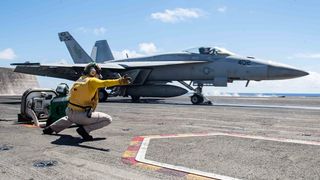In Washington last week, US Defence Secretary Mark Esper bluntly laid out the central dilemma looming over America’s national security community: “If we keep focusing on the near term, we will miss the long term and will fall irreversibly behind.”
He was talking about the need to juggle grinding global challenges such as Iran, North Korea and terrorism with the Pentagon’s imperative to focus on great-power competition with China.
The secretary was cautiously upbeat. But fixing the mismatch between the US’s vast geopolitical aims and limited means is a gruelling task. In an era of constrained budgets, it requires decision-makers from the White House and congress down to individual military services to embrace difficult trade-offs that prioritise the Indo-Pacific.
In Washington last week, US Defence Secretary Mark Esper bluntly laid out the central dilemma looming over America’s national security community: “If we keep focusing on the near term, we will miss the long term and will fall irreversibly behind.”
This is a tall order for a superpower that is unaccustomed to having to make choices, which makes Washington’s flailing focus a worry for countries such as Australia with deep stakes in a robust regional US military.
It has been two years since the Trump administration’s 2018 National Defence Strategy issued a clarion call for the US’s national security community to get serious about its top strategic priority.
Declaring “inter-state strategic competition, not terrorism, is now the primary concern in US strategy”, its twin aim was to halt the US’s drift towards strategic insolvency and retool its military for high-end competition with China.
Three major changes were needed for this correction: the US would have to wean itself off decades of Middle East combat that had dangerously eroded the readiness of its armed forces; congress would have to provide predictable defence budgets and reverse the cuts; and the Pentagon would have to shift its spending priorities from present-day operations to invest more in modernisation, advanced technologies and new war-fighting concepts to deal with a declining military dominance in the Indo-Pacific. As the bipartisan National Defence Strategy Commission warned at the time, failure to reform the US’s atrophying military could see Washington “lose the next state-versus-state war that it fights”.
To date, progress has been only mildly encouraging. In January 2018 Jim Mattis, the defence secretary at the time, ordered four Patriot missile defence systems out of Kuwait, Jordan and Bahrain, and stood down requests for an aircraft carrier to return to the Persian Gulf.
The frugalities were short-lived. Donald Trump’s withdrawal from the Iran nuclear deal months later and the uptick in US-Iranian tensions set the scene for a renewed build-up of US forces. B-52 bombers and fighter jets were deployed, missile systems were returned and more ground forces touched down.
Mattis’s cuts have been reversed and more than 10,000 additional troops are deployed or rotated to the region. It’s exactly these kind of avoidable contingencies with second-tier powers that risk hijacking Washington’s ability to focus on preparations for great power competition.
And while Trump’s Iran surge has taken place against a backdrop of efforts to rebuild the US military’s depleted war-fighting readiness, new adventures abroad serve only to make this undertaking more difficult, adding to the Pentagon’s operating and maintenance costs.
Despite being touted as growth, congress’s spending hikes during the past four years pale in comparison with the $US539bn net loss in funding that the Pentagon has endured since caps were introduced in 2011.
The outlook for the US defence budget is only slightly more encouraging. Following years of federal spending caps, congress passed a hefty deal in 2018 that lifted defence spending by 11 per cent to $US716bn across two years. Another two-year deal late last year followed, bringing the Pentagon’s budget to $US740bn ($1.1 trillion) today.
But big defence budget toplines obscure an enduring constraint on resources. Despite being touted as growth, congress’s spending hikes during the past four years pale in comparison with the $US539bn net loss in funding that the Pentagon has endured since caps were introduced in 2011. They’re playing a game of catch-up. Defence spending in real terms is flatlining at best and contracting this fiscal year.
Budget increases are not on the horizon. With the US Congressional Budget Office predicting national debt will soar to a post-World War II high of 4.7 per cent of gross domestic product throughout the 2020s, members of congress are unlikely to find political compromises to lift the defence budget above inflation.
All this puts a premium on Esper’s push to trim waste and low-priority programs through his defence-wide review, which has turned up $US5.7bn in savings in a year.
With the military services now in his crosshairs to make cuts of their own — and the US’s global Combatant Commands also under review — we can expect Esper to carve out more fat ahead of the November presidential election, redeploying it to National Defence Strategy priorities.
But single-digit savings aren’t enough to prioritise strategic competition with China. Indeed, with some estimating that the US Indo-Pacific Command alone needs 1 per cent of the annual budget — about $US7bn — to prepare for high-end deterrence and war-fighting scenarios in the region, larger reallocations will be required.
This means right-sizing the US’s global military footprint and making budget choices that favour preparations for the Indo-Pacific’s contested strategic landscape, including modernising the force; procuring advanced air, sea, space and cyber systems; prioritising next-generation technology over growing the force; and boosting research, development and experimentation.
On this score, the outlook is troubling. While the National Defence Strategy clearly calls for such reforms, the Pentagon’s three budget requests since its release have moved the needle only modestly.
Restoring military readiness, growing the force with legacy equipment, and paying for today’s operating, maintenance and personnel costs have largely crowded out serious increases in modernising the armed forces to face a peer competitor such as China.
And while the Pentagon’s 2021 spending plan, released this week, lays out an encouraging aim to boost technological research, development and experimentation to $US106.6bn — the largest request in 70 years — the overall budget is still heavily weighed down by the two-thirds it must allocate to personnel, operations and maintenance.
Incremental US progress on modernising and focusing the military is worrying for Australia. As our interests overlap with the Pentagon’s stated ambition to reorient its attention away from rogue states and forever wars and towards the significant challenges that China now poses for our region’s military balance, we must continue to urge present and future administrations and congresses to follow their own strategic guidance.
Letting our US friends know that we and other Indo-Pacific nations are watching and are concerned by the slow shift of strategic priorities and resources may help to empower those voices inside the beltway that are pushing hard for defence reform.






